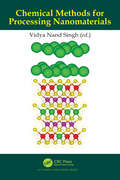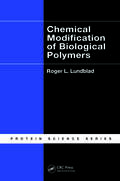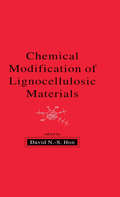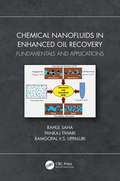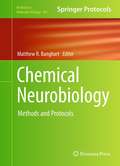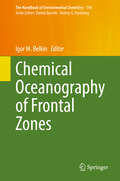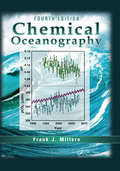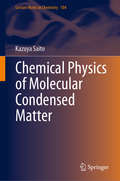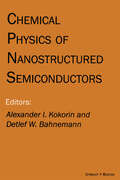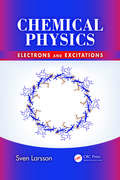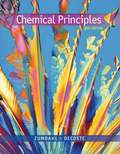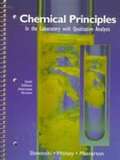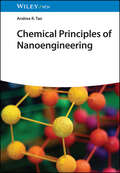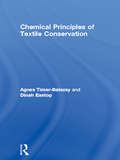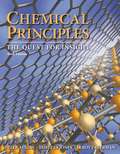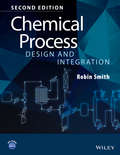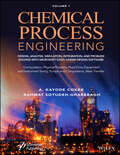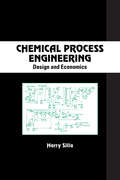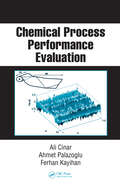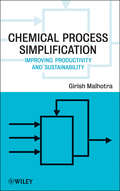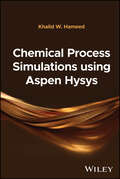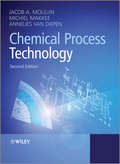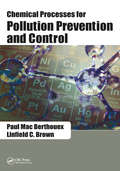- Table View
- List View
Chemical Matter: Activity Book (Amplify Core Knowledge Language Arts, Grade 5 #Unit 9)
by Amplify EducationNIMAC-sourced textbook
Chemical Methods for Processing Nanomaterials
by Vidya Nand SinghThis book discusses the latest advancements in the processing of various types of nanomaterials. The main objective of the book is to provide the reader with a comprehensive review of the latest advances in synthesis as well as processing of almost all kinds of nanomaterials using various physical and chemical methods. The book includes chapters on Chemical Methods such as microemulsions, colloidal route, wet chemical method, chemical vapor deposition technique, sol-gel method, electrodeposition for growing different kinds of nanomaterials including Chalcogenides, Metal Oxide nanostructures, perovskite nanocrystals, nano structures on patterned electrode, Low Dimensional Carbon Nanomaterials and applications at Nanoscale.
Chemical Modification of Biological Polymers
by Roger L. LundbladExamining the chemical modification of biological polymers and the emerging applications of this technology, Chemical Modification of Biological Polymers reflects the change in emphasis in this subsection of biotechnology from the study of protein structure and function toward applications in therapeutics and diagnostics. HighlightsThe basic organi
Chemical Modification of Lignocellulosic Materials
by David N.-S. HonThis volume emphasizes the growing need for wood products with advanced engineering properties. It details the fundamental principles of cellulose technology and presents current techniques to modifying the basic chemistry of lignocellulosic materials. The work: discusses the cost-efficient use of cellulose derivatives in a variety of commodities; highlights the chemical modification of wood by methods such as etherification, esterification and thermoplasticization; considers recent progress in the lignocellulosic liquefaction of wood; and more.
Chemical Nanofluids in Enhanced Oil Recovery: Fundamentals and Applications
by Rahul Saha Pankaj Tiwari Ramgopal V.S. UppaluriSustainable world economy requires a steady supply of crude oil without any production constraints. Thus, the ever-increasing energy demand of the entire world can be mostly met through the enhanced production from crude oil from existing reservoirs. With the fact that newer reservoirs with large quantities of crude oil could not be explored at a faster pace, it will be inevitable to produce the crude oil from matured reservoirs at an affordable cost. Among alternate technologies, the chemical enhanced oil recovery (EOR) technique has promising potential to recover residual oil from matured reservoirs being subjected to primary and secondary water flooding operations. Due to pertinent complex phenomena that often have a combinatorial role and influence, the implementation of chemical EOR schemes such as alkali/surfactant/polymer flooding and their combinations necessitates upon a fundamental understanding of the potential mechanisms and their influences upon one another and desired response variables. Addressing these issues, the book attempts to provide useful screening criteria, guidelines, and rules of thumb for the identification of process parametric sets (including reservoir characteristics) and response characteristics (such as IFT, adsorption etc.,) that favor alternate chemical EOR systems. Finally, the book highlights the relevance of nanofluid/nanoparticle for conventional and unconventional reservoirs and serves as a needful resource to understand the emerging oil recovery technology. Overall, the volume will be of greater relevance for practicing engineers and consultants that wish to accelerate on field applications of chemical and nano-fluid EOR systems. Further, to those budding engineers that wish to improvise upon their technical know-how, the book will serve as a much-needed repository.
Chemical Neurobiology: Methods and Protocols (Methods in Molecular Biology #995)
by Matthew R. BanghartMany advances in modern neuroscience are enabled by the availability of chemical tools that allow sensitive, precise, and quantitative measurements of, and control over, biological processes. These powerful reagents are widely used for investigating the nervous system at levels of detail ranging from ion channel structure to neural network dynamics. Recent advances in photochemistry, microscopy, and protein engineering have triggered a surge in the development and application of these interdisciplinary techniques. Chemical Neurobiology: Methods and Protocols assists with the design, characterization and validation of new chemical tools for neurobiology by providing detailed protocols of procedures and assays deemed essential for the successful development and implementation of such tools. Divided into three sections, topics cover chemical probes of membrane protein structure and function, photochemical control of protein and cellular function, and chemical probes for imaging in the nervous system. Written in the successful Methods in Molecular BiologyTM series format, chapters include introductions to their respective topics, lists of the necessary materials and reagents, step-by-step, readily reproducible protocols, and notes on troubleshooting and avoiding known pitfalls. Authoritative and easily accessible, Chemical Neurobiology: Methods and Protocols serves scientists at many levels, including students aiming to expand their perspective, laboratory researchers seeking technical guidance, and established investigators looking for creative solutions to their research problems in molecular, cellular and systems neuroscience.
Chemical Oceanography of Frontal Zones (The Handbook of Environmental Chemistry #116)
by Igor M. BelkinThis book is a unique and authoritative review of chemical fronts in the world ocean. It includes regional chapters on chemical fronts in all major oceans (Atlantic, Indian, Pacific, Arctic, and Southern) and marginal seas (North Sea, Baltic Sea, Mediterranean Sea, Gulf of Mexico, Yellow Sea, and the East Siberian Sea). Thematic chapters focus on diverse topics such as cross-frontal transfer of nutrients; diapycnal mixing and its impact on nutrient fluxes in western boundary currents (Gulf Stream and Kuroshio); front-driven physical-biogeochemical-ecological interactions; dynamics of coloured dissolved organic matter; pollutant concentration and fish contamination in frontal zones; distribution of microplastics in the ocean, and Lagrangian methods to study the transport of marine litter. This volume will appeal to a broad audience, including researchers, instructors, students, and practitioners of all kinds involved in scientific and applied research, environment protection and conservation, and maritime industries including fisheries, aquaculture, and mining.
Chemical Oceanography: Volume 5, Chemical Oceanography (Harte Research Institute For Gulf Of Mexico Studies Series, Sponsored By The Harte Research Institute For Gulf Of Mexico Studies, Texas A&m University-corpus Christi Ser.)
by Frank J. MilleroOver the past ten years, a number of new large-scale oceanographic programs have been initiated. These include the Climate Variability Program (CLIVAR) and the recent initiation of the Geochemical Trace Metal Program (GEOTRACES). These studies and future projects will produce a wealth of information on the biogeochemistry of the world's oceans. Aut
Chemical Physics of Molecular Condensed Matter (Lecture Notes in Chemistry #104)
by Kazuya SaitoThis book fills a gap in knowledge between chemistry- and physics-trained researchers about the properties of macroscopic (bulk) material. Although many good textbooks are available on solid-state (or condensed matter) physics, they generally treat simple systems such as simple metals and crystals consisting of atoms. On the other hand, textbooks on solid-state chemistry often avoid descriptions of theoretical background even at the simplest level. This book gives coherent descriptions from intermolecular interaction up to properties of condensed matter ranging from isotropic liquids to molecular crystals. By omitting details of specific systems for which comprehensive monographs are available—on liquid crystals and molecular conductors, for instance—this book highlights the effects of molecular properties, i.e., the presence of the shape and its deformation on the structure and properties of molecular systems.
Chemical Physics of Nanostructured Semiconductors
by Alexander I. Kokorin Detlef BahnemannDeep and detailed discussions on chemistry, chemical physics, photoelectrochemistry, photophysics, photocatalysis and possible applications of nanostructured semiconductor materials have shown increasing interest in the matter by scientists representing various research areas as well as industrial enterprises. Indeed, solar energy conversion and ch
Chemical Physics: Electrons and Excitations
by Sven LarssonA full understanding of modern chemistry is impossible without quantum theory. Since the advent of quantum mechanics in 1925, a number of chemical phenomena have been explained, such as electron transfer, excitation energy transfer, and other phenomena in photochemistry and photo-physics. Chemical bonds can now be accurately calculated with the hel
Chemical Principles (Eighth Edition)
by Steven S. Zumdahl Donald J. DecosteDevelop the qualitative, conceptual foundation you need to think like a chemist with CHEMICAL PRINCIPLES, 8e. Designed for students with solid mathematical preparation, this best-seller emphasizes models, everyday applications of chemistry, and a thoughtful, step-by-step problem-solving approach.
Chemical Principles in the Laboratory with Qualitative Analysis: Sixth Edition
by William L. Masterton Wayne C. Wolsey Emil J. SlowinskiThis alternate version of Slowinski, CHEMICAL PRINCIPLES IN THE LABORATORY, Sixth Edition contains most of the original experiments as well as a full qualitative analysis scheme for the common cations and anions, in order to provide students with an opportunity to experience more descriptive chemistry than is available in most laboratory programs.
Chemical Principles of Nanoengineering
by Andrea R. TaoChemical Principles of Nanoengineering Understand the chemical properties of nanomaterials with this thorough introduction Nanomaterials, which possess at least one dimension lower than 100 nanometers, are increasingly at the forefront of technological and chemical innovation. The properties of these uniquely minute materials give them distinctive applications across a huge range of industries and research fields. It is therefore critical that the next generation of engineers and materials scientists understand these materials, their chemical properties, and how they form bonds. Chemical Principles of Nanoengineering answers this need with a thorough, detailed introduction to nanomaterials and their underlying chemistry. It particularly emphasizes the connection between nanomaterial properties and chemical bonds, which in turn allows readers to understand how these properties change at different scales. The result is a critical resource for understanding these increasingly vital materials. Chemical Principles of Nanoengineering readers will also find: Step-by-step arrangement of material to facilitate learning in sequence and gradual, self-guided progress End-of-chapter problems and key concept definitions to reinforce learning Detailed coverage of important nanomaterials like quantum dots, carbon nanotubes, graphene, and more Chemical Principles of Nanoengineering is a must-have for advanced undergraduates and beginning graduate students in materials science, chemical engineering, chemistry, and related fields.
Chemical Principles of Textile Conservation (Butterworth-heinemann Series In Conservation And Museology)
by Dinah Eastop Agnes Timar-Balazsy'Chemical Principles of Textile Conservation' provides must-have knowledge for conservators who do not always have a scientific background. This vital book brings together from many sources the material science necessary to understand the properties, deterioration and investigation of textile artefacts. It also aids understanding of the chemical processes during various treatments, such as: cleaning; humidification; drying; disinfestation; disinfection; and the use of adhesives and consolidants in conservation of historical textiles. Textile conservators will now have ready access to the necessary knowledge to understand the chemistry of the objects they are asked to treat and to make informed decisions about how to preserve textiles. The combination of a chemist and a conservator provides the perfect authorial team. It ensures a unique dual function of the text which provides textile conservators with vital chemical knowledge and gives scientists an understanding of textile conservation necessary to direct their research. The many practical examples and case studies illustrate the utility of the relatively large chemical introduction and the essential chemical information which is included. The case studies, many illustrated in colour, range from the treatment of the Ghandis' clothes, high-altitude flying suits and a Mary Quant raincoat, to the Hungarian Coronation Mantle.
Chemical Principles: The Quest for Insight (6th Edition)
by Peter Atkins Loretta Jones Leroy LavermanWritten for calculus-inclusive general chemistry courses, Chemical Principles helps students develop chemical insight by showing the connections between fundamental chemical ideas and their applications. Unlike other texts, it begins with a detailed picture of the atom then builds toward chemistry's frontier, continually demonstrating how to solve problems, think about nature and matter, and visualize chemical concepts as working chemists do. Flexibility in level is crucial, and is largely established through clearly labeling (separating in boxes) the calculus coverage in the text: Instructors have the option of whether to incorporate calculus in the coverage of topics. The multimedia integration of Chemical Principles is more deeply established than any other text for this course. Through the unique eBook, the comprehensive ChemPortal, Living Graph icons that connect the text to the Web, and a complete set of animations, students can take full advantage of the wealth of resources available to them to help them learn and gain a deeper understanding.
Chemical Process Design and Integration: Design And Integration
by Robin SmithWritten by a highly regarded author with industrial and academic experience, this new edition of an established bestselling book provides practical guidance for students, researchers, and those in chemical engineering. The book includes a new section on sustainable energy, with sections on carbon capture and sequestration, as a result of increasing environmental awareness; and a companion website that includes problems, worked solutions, and Excel spreadsheets to enable students to carry out complex calculations.
Chemical Process Engineering Volume 1: Design, Analysis, Simulation, Integration, and Problem Solving with Microsoft Excel-UniSim Software for Chemical Engineers Computation, Physical Property, Fluid Flow, Equipment and Instrument Sizing
by Rahmat Sotudeh-Gharebagh A. Kayode CokerCHEMICAL PROCESS ENGINEERING Written by two of the most prolific and respected chemical engineers in the world, this groundbreaking two-volume set is the “new standard” in the industry, offering engineers and students alike the most up-do-date, comprehensive, and state-of-the-art coverage of processes and best practices in the field today. This first new volume in a two-volume set explores and describes integrating new tools for engineering education and practice for better utilization of the existing knowledge on process design. Useful not only for students, professors, scientists and practitioners, especially process, chemical, mechanical and metallurgical engineers, it is also a valuable reference for other engineers, consultants, technicians and scientists concerned about various aspects of industrial design. The text can be considered as a complementary text to process design for senior and graduate students as well as a hands-on reference work or refresher for engineers at entry level. The contents of the book can also be taught in intensive workshops in the oil, gas, petrochemical, biochemical and process industries. The book provides a detailed description and hands-on experience on process design in chemical engineering, and it is an integrated text that focuses on practical design with new tools, such as Excel spreadsheets and UniSim simulation software. Written by two industry and university’s most trustworthy and well-known authors, this book is the new standard in chemical, biochemical, pharmaceutical, petrochemical and petroleum refining. Covering design, analysis, simulation, integration, and, perhaps most importantly, the practical application of Microsoft Excel-UniSim software, this is the most comprehensive and up-to-date coverage of all of the latest developments in the industry. It is a must-have for any engineer or student’s library.
Chemical Process Engineering: Design And Economics (Chemical Industries Ser. #Vol. 96)
by Harry SillaThis illustrative reference presents a systematic approach to solving design problems by listing the needed equations, calculating degrees-of-freedom, developing calculation procedures to generate process specifications, and sizing equipment. Containing over thirty detailed examples of calculation procedures, the book tabulates numerous easy-to-fol
Chemical Process Performance Evaluation (Chemical Industries)
by Ali Cinar Ahmet Palazoglu Ferhan KayihanThe latest advances in process monitoring, data analysis, and control systems are increasingly useful for maintaining the safety, flexibility, and environmental compliance of industrial manufacturing operations. Focusing on continuous, multivariate processes, Chemical Process Performance Evaluation introduces statistical methods and modeling te
Chemical Process Simplification
by Girish K. MalhotraWhile emphasizing conservation and sustainable strategies, this book provides steps to improve the manufacturing technologies used in creating products. By simplifying the chemistry, process development, manufacturing practices and processes, the book provides a structured approach to producing quality products with little waste, making the process not only efficient but environmentally friendly. Illustrated with case studies, this is an essential resource for chemical engineers, chemists, plant engineers, and operating personnel in any chemical related businesses.
Chemical Process Simulations using Aspen Hysys
by Khalid W. HameedAn intuitive guide to using Aspen HYSYS for chemical, petrochemical, and petroleum industry process simulations, including interactive process flow diagrams In Chemical Process Simulations using Aspen Hysys, distinguished lecturer Dr. Khalid W. Hameed delivers an up-to-date and authoritative discussion of the simulation and design of chemical, petrochemical, and petroleum industry processes using Aspen HYSYS. The book includes coverage of many chemical engineering topics including fluid flow, reactors, unit operation of heat and mass transfer, oil refinery process, and control systems. Readers will also find highly interactive process flow diagrams for building and navigating through large simulations, as well as: A thorough introduction to the use of Aspen HYSYS for the chemical, oil, and petrochemical industriesSkill development techniques for users of Aspen HYSYS and strategies for improving the accuracy of results Practical discussions of Dynamic State Simulation with explanations of how to install control systems for the process using flash separator, gas processing, and advanced process control such as ratio control, cascade control, and split range controlIllustrative examples of Plant Wide Projects that demonstrate the ability of Aspen HYSYS to perform a full plant Perfect for research and development engineers in the fields of petrochemical, chemical, and petroleum engineering, Chemical Process Simulations using Aspen HYSYS will also benefit researchers with an interest in the area.
Chemical Process Technology
by Jacob A. Moulijn Annelies E. van Diepen Michiel MakkeeWith a focus on actual industrial processes, e.g. the production of light alkenes, synthesis gas, fine chemicals, polyethene, it encourages the reader to think "out of the box" and invent and develop novel unit operations and processes. Reflecting today's emphasis on sustainability, this edition contains new coverage of biomass as an alternative to fossil fuels, and process intensification.The second edition includes:New chapters on Process Intensification and Processes for the Conversion of BiomassUpdated and expanded chapters throughout with 35% new material overallText boxes containing case studies and examples from various different industries, e.g. synthesis loop designs, Sasol I Plant, Kaminsky catalysts, production of Ibuprofen, click chemistry, ammonia synthesis, fluid catalytic crackingQuestions throughout to stimulate debate and keep students awake!Richly illustrated chapters with improved figures and flow diagramsChemical Process Technology, Second Edition is a comprehensive introduction, linking the fundamental theory and concepts to the applied nature of the subject. It will be invaluable to students of chemical engineering, biotechnology and industrial chemistry, as well as practising chemical engineers. From reviews of the first edition:"The authors have blended process technology, chemistry and thermodynamics in an elegant manner... Overall this is a welcome addition to books on chemical technology." - The Chemist"Impressively wide-ranging and comprehensive... an excellent textbook for students, with a combination of fundamental knowledge and technology." - Chemistry in Britain (now Chemistry World)
Chemical Processes for Pollution Prevention and Control
by Paul Mac Berthouex Linfield C. BrownThis book examines how chemistry, chemical processes, and transformations are used for pollution prevention and control. Pollution prevention reduces or eliminates pollution at the source, whereas pollution control involves destroying, reducing, or managing pollutants that cannot be eliminated at the source. Applications of environmental chemistry are further illustrated by nearly 150 figures, numerous example calculations, and several case studies designed to develop analytical and problem solving skills. The book presents a variety of practical applications and is unique in its integration of pollution prevention and control, as well as air, water, and solid waste management.

